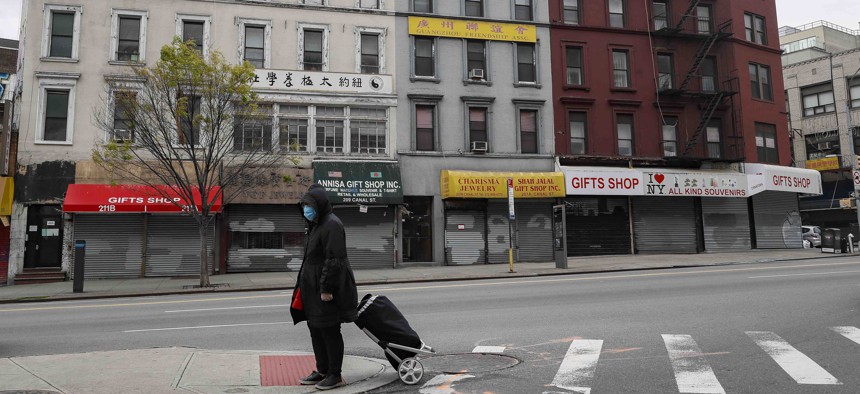Fed Expands Lending Program to Include More Counties and Cities

A pedestrian wearing a protective mask stands on a corner on an empty Canal Street as businesses remain closed due to continuing social distancing restrictions, Monday, April 27, 2020, in New York City. AP Photo/John Minchillo

Connecting state and local government leaders
New guidelines for the initiative lower the population threshold for local governments to qualify, and allow for short-term debt to be repaid over a lengthier 36-month timeframe.
The Federal Reserve will expand a $500 billion lending program that is intended to help states and localities meet their credit and cash-flow needs as the coronavirus outbreak hammers their finances.
On Monday, the Federal Reserve Board announced that it was lowering the population threshold for local governments to borrow under the Municipal Liquidity Facility initiative. The central bank will also extend the maximum timeframe for paying off the debt to 36 months.
Initial plans for the facility called for it to purchase short term notes from states, counties with populations of at least two million, and cities with populations of at least one million. The revised rules lower the eligible population level to 500,000 for counties and 250,000 for cities.
“The new population thresholds allow substantially more entities to borrow directly from the MLF than the initial plan,” the Fed said in its announcement.
The Fed also moved out the termination date for when notes will no longer be purchased under the program, pushing it to Dec. 31, from Sept. 30 of this year.
Additionally, the central bank said Monday that certain multi-state entities would be able to participate in the expanded program.
Because of delayed and weakened tax collections, and other financial fallout tied to the coronavirus, it’s expected state and local short-term borrowing needs will outstrip investor demand for their debt, at least without substantially pushing up borrowing costs.
The Fed's liquidity facility is meant to help address these issues. The facility isn’t up and running yet.
The Government Finance Officers Association, which advocates on behalf of federal, state and local finance officials, was among those that urged the Federal Reserve’s board to broaden the program so that it covered more local governments.
It noted in an April 15 letter that only about 75 potential borrowers, including the states and large enough local governments, would qualify for it under the original guidelines.
GFOA also pushed for extending the deadline for borrowing to December instead of September.
The group noted that while states are allowed to use proceeds from the program to support smaller counties and cities, few have a mechanism in place to do so and that changing this would in some cases require legislative action or overcoming legal obstacles.
It’s also possible that some jurisdictions might not know their liquidity needs by September, GFOA pointed out.
The National Association of State Treasurers in an April 16 letter to Federal Reserve Chairman Jerome Powell applauded the creation of the liquidity facility, but added that its utility "will be determined by its borrowing rates, barriers to access, terms and other key details.”
Bill Lucia is a Senior Reporter for Route Fifty and is based in Olympia, Washington.

NEXT STORY: Millions of People Face Stimulus Check Delays for a Strange Reason: They Are Poor





